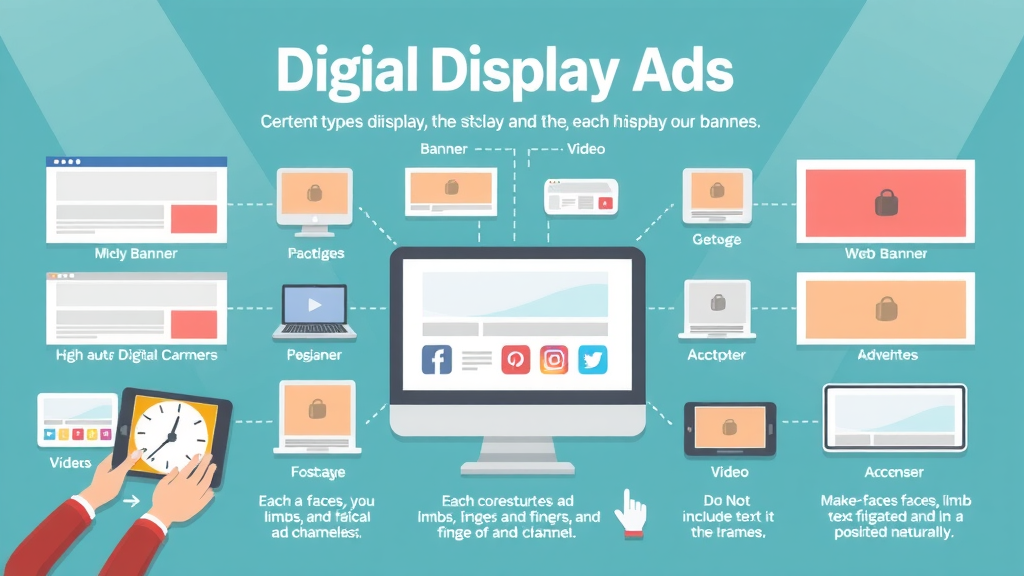Did you know that over 50% of marketers say their display advertising campaigns don’t hit their return on investment goals? If your display ad performance feels stagnant and your ad spend isn’t translating into conversions, you’re not alone. With brands pumping billions into online advertising each year, underperforming display ads mean wasted budget and missed opportunities. In this comprehensive guide, we’ll explore why display advertising often misses the mark—and reveal proven steps to transform your next campaign from average to outstanding.
Startling Statistics: Why Most Display Advertising Campaigns Underperform
Display advertising is everywhere online, but that broad visibility doesn’t always drive good results. Despite the promise of banner ads, video ads, and rich media, click-through rates for display ads remain stubbornly low—often under 0.5%. In fact, more than half of marketers report that their display ad campaigns fail to meet ROI targets. This gap between expectation and reality can be attributed to several issues, such as poor targeting, lackluster ad creative, and ineffective calls to action. With so much at stake, understanding why display ads underperform is the first step toward building campaigns that actually convert.
Many advertisers fall into common traps like “set it and forget it” ad management, not properly segmenting their target audience, and ignoring historical ad performance data. Banner blindness—a phenomenon where users mentally filter out banner ads—further complicates matters and diminishes engagement. Yet, with the right strategy, creative spark, and ongoing optimization, brands can flip the script and start driving measurable value from their display advertising campaigns.
The Hidden Truths Behind Display Ad Click-Through Rates
While it’s easy to blame low click-through rates on user apathy, the real causes are usually hiding beneath the surface. Banner blindness is a major obstacle: users have grown so accustomed to seeing display ads that their brains literally tune them out. Add to that ineffective targeting—showing ads to people with zero interest or relevance—and CTRs drop even further. Creative fatigue, where audiences tire of seeing the same message, and weak calls to action also play enormous roles in suppressing engagement. Marketers must get smart about breaking through user resistance by crafting highly personalized, visually arresting ads backed by data-driven audience research.
"Over 50% of marketers say their display advertising campaigns miss ROI expectations."
It’s not just about the number of impressions or clicks. If your display ad isn’t relevant or persuasive, even the best-looking banners on the highest-traffic sites will fall flat. Understanding these hidden truths gives marketers a competitive advantage and a clear starting point for optimization.
Common Reasons Display Ads Miss the Mark
- Banner blindness: Users ignore ads automatically, reducing visibility and clicks.
- Poor targeting: Ads shown to the wrong audience fail to engage or convert.
- Unengaging creative: Bland visuals and messages get lost in the digital noise.
- Weak call to action: Vague or uninspiring CTAs fail to prompt users to act.

What You'll Learn About Successful Display Advertising
- The current landscape and biggest opportunities in display advertising
- Types of display ads and how to use them for top results
- Step-by-step methods for building a high-performing display ad campaign
- Winning strategies for common display ad challenges
- How to measure and optimize your display advertising ROI
What is Display Advertising? Core Concepts Explained
Put simply, display advertising involves promoting your brand, products, or services through visual ads—like banners, images, videos, and even interactive ad formats—across websites, social media, and apps. Unlike search ads, which target users with active intent, display ads put your message in front of users even when they’re not searching. This strategy boosts brand awareness, attracts new audiences, and supports remarketing efforts, making it a core tactic in any diversified digital marketing plan.
Display advertising campaigns can be scaled to fit any budget and allow for precise targeting by demographics, interests, location, and even browsing behavior. Popular placements include prominent spots on high-traffic websites and in-feed placements on social media platforms. Success in display advertising relies on leveraging varied ad formats, monitoring performance, and continuously tweaking targeting and creative elements for maximum impact.

| Definition | Common Types |
|---|---|
| The use of banners, images, and video to promote brands across websites and social media. | Banner ads, rich media, video ads, native ads, social display ads |
How Display Ad Networks Work
Display ad networks—such as the Google Display Network, Facebook Audience Network, and others—connect advertisers with millions of potential placements across sites and apps. These networks act as intermediaries, using sophisticated algorithms to match your display ads with relevant audiences based on interests, demographics, and online behavior. When you launch a display ad campaign, the ad network determines where and when your ads appear, allowing for massive reach while maintaining control over your ad spend and targeting criteria. Most ad networks offer robust analytics, so you can track impressions, clicks, conversions, and more to understand performance and justify your investment.
This structure enables advertisers to buy ad space programmatically and at scale. By segmenting your target audience and allocating budget wisely, ad networks help maximize exposure and boost the chances of driving conversions—provided your creative and messaging are strong. Mastering how networks operate is crucial for crafting effective display advertising campaigns that capitalize on a blend of automation and customization.
For those encountering persistent challenges with their campaigns, exploring practical solutions can make a significant difference. If you’re looking for actionable advice on overcoming common hurdles, this guide to fixing underperforming display ad campaigns offers step-by-step tactics to help you get back on track.
Key Features of a Display Advertising Campaign
Successful display advertising campaigns usually share several key elements: sharply defined objectives, well-researched target audiences, attention-grabbing creative assets, and clear calls to action. Marketers must also choose the right ad format—be it a static banner ad, dynamic rich media, or engaging video ad—that aligns with their goals. Ongoing testing and optimization, powered by analytics, enable advertisers to refine their messaging, creative, and targeting over time for better ROI.
Other campaign features include retargeting (showing ads to users who have already interacted with your brand), frequency caps (limiting how often someone sees your ad), and device-specific optimization. By methodically checking every aspect of your display advertising campaign, you’ll set yourself up for consistent improvement and measurable growth.
Types of Display Advertising: Which Formats Drive Results?
The effectiveness of your display advertising hinges largely on the types of display ad formats you use. Different ad formats serve unique purposes and offer varying levels of engagement, reach, and branding potential. The three main categories are the ever-present banner ads, interactive rich media ads, and highly engaging video ads. Understanding which ad format aligns best with your campaign objectives is vital, ensuring your message connects with your audience in the most compelling way possible.
It’s not just about slapping a logo on a static image. Innovations in digital advertising mean you can experiment with native ads (which blend with site content), carousel ads (especially on social media), or even gamified interactive ad experiences. Each format offers particular benefits and best-use scenarios, and combining multiple types can further elevate your digital ad strategy by reaching users across multiple touchpoints.
Banner Ads vs. Rich Media vs. Video Ads
Banner ads are the foundation of display advertising, ideal for building brand awareness on a wide scale. While these static image ads remain popular due to their simplicity and cost-effectiveness, engagement rates can be low if designs lack creativity. Rich media ads boost interaction by incorporating animation, sliders, or even mini-games, capturing attention and encouraging more user engagement. Video ads, meanwhile, are top performers at telling your brand story and driving emotional responses. As Internet speeds increase and video consumption soars, video ads deliver higher engagement, longer view times, and greater impact—especially when optimized for mobile and social media placements.
| Format | Best Use | Engagement |
|---|---|---|
| Banner Ad | Brand awareness | Low |
| Rich Media | Product demos | Medium |
| Video Ad | Storytelling | High |

Innovative New Types of Display Advertising
The rise of interactive ad formats—think playable demos, AR/VR experiences, and shoppable ads—has brought a new dynamism to display advertising. These next-generation ad types invite users to click, swipe, or even participate directly within the ad, making user experience more engaging and memorable. Native ads that blend seamlessly into news feeds, or carousel ads on social media, also help brands avoid banner blindness and reach users in subtle but effective ways. With consumers’ attention spans shorter than ever, leveraging innovative formats is a must for brands looking to cut through digital clutter and drive higher returns.
Adopting the latest advances in display ad technology—such as sequential messaging, location-based targeting, or interactive video—can set your brand apart from the competition. By putting the user experience at the center of your digital ad strategy, you dramatically increase the likelihood of engagement, shares, and ultimately, conversions.
Social Media's Role in Modern Display Ads
Social media has taken center stage in the world of display advertising. Platforms like Facebook, Instagram, LinkedIn, and Twitter provide unmatched reach, sophisticated targeting, and a range of ad formats such as stories, carousel, and in-feed video ads. These channels excel at connecting brands with their target audience in contextually rich, interactive environments where users are already primed to discover new products and services. The social component also opens up avenues for viral sharing, user interaction, and better audience segmentation based on interests, behaviors, and historical data.
Because of the robust analytics and creative flexibility offered by social platforms, marketers can fine-tune their display ad campaigns in real time—testing images, headlines, CTA buttons, and even color schemes to find what works best. Social media’s integration with e-commerce tools (like Instagram Shopping) also means display ads can now drive direct conversions without even leaving the platform. The lesson is clear: closing the loop between creative and audience targeting is easier and more impactful than ever before.

Building a High-Performing Display Ad Campaign: Step-by-Step
- Define your display advertising campaign objectives: Start by pinpointing what you want to achieve—brand awareness, lead generation, or direct sales.
- Research your target audience for better ad targeting: Use analytics, customer data, and personas to understand who your campaigns should reach and where.
- Choose the right types of display ads and ad networks: Select ad formats and networks that align with your strategy, goals, and where your audience spends time.
- Design compelling display ad creative and call to action elements: Employ bold graphics, striking copy, and a clear CTA to drive clicks to your landing page or offer.
- Monitor, analyze, and optimize your ad campaign performance: Use tools like Google Display Network analytics to continuously track key metrics and improve results over time.

Choosing the Best Display Ad Size for Your Objectives
Ad size directly impacts visibility, engagement, and conversion rates. The most popular sizes—like 300x250 (sidebar), 728x90 (leaderboard), and 160x600 (skyscraper)—have distinct advantages in terms of placement and performance. For example, leaderboard ad sizes at the top of a webpage grab immediate attention, while sidebar or skyscraper formats offer persistent visibility as users scroll. Optimizing your ad campaign means not just selecting the right ad format, but also choosing the best ad size for your message and audience. A/B testing different ad sizes and placements is crucial for discovering what resonates and delivers the highest ROI.
| Ad Size | Placement | Conversion Rate |
|---|---|---|
| 300x250 | Sidebar | 2.1% |
| 728x90 | Top Leaderboard | 1.7% |
| 160x600 | Skyscraper | 1.3% |
Why a Strong Call to Action Matters in Display Advertising
Your ad campaign lives or dies on the strength of its call to action (CTA). Without a compelling CTA, even the most visually stunning ad format will fail to prompt your audience to take the next step—whether that’s clicking through to a landing page, making a purchase, or signing up for a newsletter. A well-crafted CTA uses clear and action-oriented language, creates a sense of urgency or value, and stands out both visually and contextually. Testing multiple versions of your CTA can double or even triple your results, so don’t settle for “Learn More” if “Get Your Free Trial” or “Shop Now” can do the job more powerfully.
"The right call to action can double your display ad campaign results."
How to Optimize Your Display Ads for Better Results
Optimization separates great display advertising from wasted budgets. The secret is to leverage targeting capabilities, refine creative assets, and constantly review real-time analytics. Segmentation, retargeting, and creative improvement cycles are the cornerstones of ongoing growth. Rather than “set and forget,” your display ad campaign should evolve along with your audience, market, and performance data.
Consider deploying multiple versions of your ads and running split tests to identify what works best for different segments of your target audience. Optimize for both desktop and mobile by designing responsive creative. By continually refreshing your creative and message, you keep your audience engaged and avoid fatigue—ultimately leading to higher click-throughs, conversions, and ROI.
Retargeting & Audience Segmentation Essentials
Retargeting is a powerful way to recapture audiences who have already expressed an interest in your brand by visiting your website or interacting with your previous ads. Paired with audience segmentation—grouping your target market by demographics, interests, or behaviors—you can deliver hyper-relevant display ads that reignite interest and drive conversions. Retargeting display ads act as helpful reminders to return to a landing page, complete a purchase, or sign up for a service, dramatically increasing conversion rates for your ad campaigns. Use dynamic creative that adapts to user preferences, and adjust ad frequency to avoid coming across as spammy or repetitive.
Proper segmentation means that your ad spend focuses only on audiences most likely to respond. This boosts efficiency, conserves budget, and increases campaign ROI. Platforms like the Google Display Network and Facebook Ads offer granular controls to refine your reach for every campaign you launch, so make these features a core part of your optimization strategy.
Improving Display Ad Creative: Best Practices
- Use bold headlines and contrasting colors: Capture attention with strong visuals that stand out against digital clutter and ensure your brand message is immediately clear.
- Highlight unique value propositions: Communicate what makes your product or service different—and why users should care—using concise, benefit-driven messaging.
- Test different CTA placements: Try buttons in various locations within your ad to see which layout earns the most clicks and conversions.
- Optimize for both mobile and desktop: Ensure your ad displays perfectly on all devices, as mobile accounts for a significant (and growing) portion of digital ad impressions.

Measuring Display Advertising Effectiveness: Metrics That Matter
To prove and improve ROI, advertisers must track the right metrics for every display advertising campaign. Key data points include:
- Impressions vs. Clicks: How many times your ad was seen compared to how many times it was clicked.
- CTR (Click-Through Rate): The percentage of impressions that turn into clicks, highlighting ad relevance and creative performance.
- Conversion rates: What percentage of users clicked your ad and then completed your desired action (purchase, sign-up, download, etc.).
- Viewable impressions: The number of ads actually seen by users, not just loaded by the browser.
- Cost per action (CPA): How much you’re paying on average for each desired result, like a sale or sign-up.
By analyzing these metrics regularly, you can spot underperforming ads, adjust your targeting, and refine your creative to drive higher quality results from your ad campaigns.
Google Display Network Analytics – Interpreting the Data
Google Display Network (GDN) provides advertisers with robust analytics to track ad performance at a granular level. You can view data on impressions, clicks, CTR, conversions, viewability, and CPA across different audience segments, ad formats, placements, and devices. By leveraging these insights, marketers can optimize every aspect of their display advertising—from refining creative to reallocating ad spend toward the highest-converting placements. Don’t just look for “vanity metrics”—dig deep into viewable impressions, post-click engagement, and multi-touch attribution to understand your true ROI and inform smart decisions for future campaigns.
Integrate GDN analytics with conversion tracking and A/B test results for a clear, actionable picture. Use custom dashboards and automated reports to spot trends and respond fast to changing audience behaviors. With the right data, your next advertising campaign can outperform the last.
People Also Ask About Display Advertising
What is meant by display advertising?
Answer: Display advertising uses visual ads such as banners, images, and videos on digital platforms to reach and engage audiences.
What is an example of display advertising?
Answer: A banner ad promoting a new running shoe on a popular sports website is an example of display advertising.

How effective is display advertising?
Answer: Display advertising effectiveness depends on targeting, creative, and placement; when done well, it can drive significant impressions and conversions.
What are the advantages of display advertising?
Answer: Advantages include broad reach, brand awareness, visual storytelling, retargeting, and flexible budget options.
FAQs About Display Advertising
What makes a successful display ad?
A successful display ad is visually engaging, quickly communicates a clear value proposition, and includes a compelling call to action. It’s targeted to the right audience and tailored for specific placements and devices to maximize relevance and effectiveness.
Which industries benefit most from display advertising?
Industries that thrive on brand awareness and visual storytelling—such as retail, e-commerce, automotive, travel, entertainment, and real estate—see especially high value from display advertising. However, nearly all sectors can benefit by targeting the right audience and leveraging the right ad formats for their goals.
How does display advertising compare to search ads?
Display advertising creates demand and builds brand awareness by reaching broad audiences across websites and apps, while search ads capture users with active purchase intent. Both are vital for a balanced marketing strategy, with display offering top-of-funnel reach and search delivering bottom-funnel conversions.
What trends are shaping the future of display ads?
Trends include greater use of video ads, personalization via AI, integration with digital TV and social channels, adoption of interactive and shoppable ad formats, and a shift toward privacy-conscious targeting solutions. Staying ahead means embracing new ad technologies and always optimizing for user engagement.
Key Takeaways on Display Advertising Success
- Display advertising remains a powerful tool for building brand awareness and engaging new audiences
- Strong creative and advanced targeting drive campaign ROI
- Consistent campaign review and optimization are key to sustained success
- Integrating display with channels like social media and search amplifies results
Conclusion: Transform Your Display Advertising and Boost Results
"Display advertising is only as strong as its strategy. Rethink, refocus, and activate new growth."

If you’re ready to take your digital marketing to the next level, consider exploring how advanced strategies and emerging technologies can further amplify your results. Delve into the broader landscape of paid display advertising and discover expert insights on maximizing sales and ROI by visiting Master Paid Display Advertising to Boost Your Sales Today. This resource uncovers high-level tactics, integration tips, and the latest trends to help you stay ahead of the competition. Elevate your campaigns with a holistic approach and unlock new growth opportunities for your brand.
Ready to Grow? Call Digital Media Marketing Today at 586-997-0001

 Add Row
Add Row  Add
Add 




Write A Comment